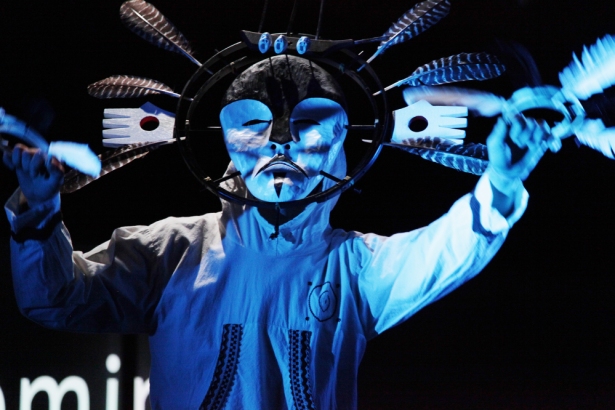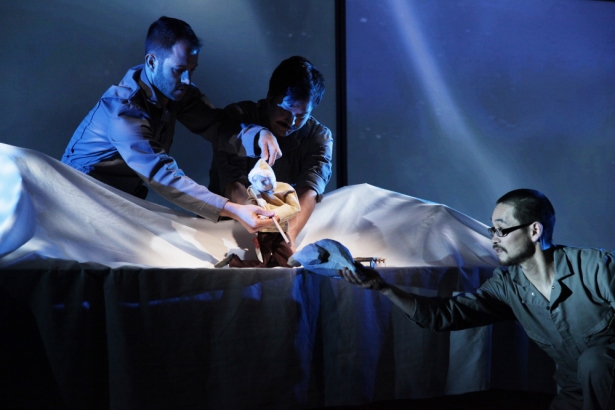This post comes from the Artists and Climate Change Blog
Around this time last year, I took a moment to reflect on the theatrical experiences I’d had and what I’d take with me into the new year. I’m embarking on another year-end review, to link up my encounters in the theatre with my relationship to this topsy-turvy world we’re living in. Like last year, most of these plays are not explicitly about climate, nor do I seek to offer criticism on every show I’ve seen. I’ve got my climate lenses on, and will highlight instances that have inspired me creatively and politically.
My year started off with a meeting of theatre artists engaged on climate issues, which in turn formed a network called CLIMATE LENS. From this conversation, and participant Una Chaudhuri, comes the term itself: climate lens. As our Facebook Group describes, climate lens reframes climate change as more than a topic or problem. In a way similar to how feminism situates gender in the context of patriarchy, climate lens “proposes climate as the clarifying lens through which to reveal and resist the socio-political issues of our day,†exploring “theatrical ways of partnering with the more-than-human world.†To view an experience with climate lenses is to acknowledge climate as a force that has always existed, and to intersect climate injustices with other systems of oppression in human society. This term and its explanatory language has offered me a new set of tools with which to experience performance.
This season, I got to experience Ping Chong + Company for the first time. Through multimedia, movement, and puppetry, their piece ALAXSXA | ALASKA unpacks Alaska’s political history juxtaposing memoirs from two of the show’s creators, Gary Upay’aq Beaver (Central Yup’ik) and Ryan Conarro. The show opens with Central Yup’ik drumming and dancing, and from there, scenes unfold almost seamlessly between monologues or dialogues between Gary and Ryan, humorous yet unsettling “history lessons,†and movement sequences with objects. Vibrant images of Alaska, from mountains to snowy forests, are projected throughout the show. In one narrative, a fox is being chased through the snow, brought to life onstage by a puppet and a projected snowscape. Both the fox puppet and the projected landscape became characters in the play, and I was able to see the world through the eyes of this persecuted fox. The state of Alaska also becomes a character, in scenes detailing colonialism and nuclear deals.
Through the climate lens, I recognized that the environment as depicted in the story – from the fox in the snow, to the land of Alaska as it is “bought and sold†– has agency. Despite the actions of some humans who have taken it upon themselves to “claim ownership†to certain animals or places, there is an innate sovereignty that exists in the natural world, and through this recognition, my empathy was expanded. Another vital element to the play was the encounter between Native and non-Native, as expressed through Gary and Ryan’s accounts. The individual stories of these two men lays out cultural differences, but also bridge cultures through performance and shared interest. My view through a climate lens juxtaposes the political and social injustices of colonialism with how and where Gary lives, and how life for him and other Central Yup’ik people has changed.

Ping Chong + Company’s ALAXSXA | ALASKA. Photo by Theo Cote.
ALAXSXA | ALASKA included a talkback with the show creators. One question was asked about what the creators want audiences to take away from their production. The response from the team, particularly Ryan, resonated with me as an activist theatremaker: whatever audiences experience during the production, whatever questions and feelings arise, that is what the creators behind Ping Chong + Company want audiences to take away. It was validating for me to hear that theatre artists are not tasked with prescribing an experience or set of ideals for audiences, but instead offer moments for audiences to encounter in juxtaposition with their own worldviews.

Ping Chong + Company’s ALAXSXA | ALASKA. Photo by Theo Cote.
Diana Oh’s  sparkly and rockin’ {my lingerie play} 2017: THE CONCERT AND CALL TO ARMS!!!!!!!!! The Final Installation is the most colorful production I’ve seen this year. As part of a series of installments of public demonstrations against rape culture, it was a community-building experience liked I’ve never experienced before. Walking into New York’s Rattlestick Playwrights Theater was like entering a glittering wonderland. From that moment, the audience is an active participant in the performance. Everyone got a brown paper bag to write why they create. These bags became part of the set, as we got to choose where in the space we wanted our bag to go. Everyone had the opportunity to rock glitter eye shadow and temporary tattoos, in the spirit of self-expression and fun. At the top of the show, we read a list of nine agreements, acknowledging our consent in the experience. The performance was a concert of songs by Diana, with interludes and scenes about her experiences with dating and sex. We got to take part in her anecdotes via a few invitations: Diana offers to give a haircut to an audience member, she demonstrates consent with a volunteer from the audience, and we get to blow bubbles for the fun of it and in triumph over oppressive gender norms.
Diana’s stories are full of pain and suffering, which she shared in such a way that validated and made space for our pain and suffering as well. There was also immense joy and appreciation. {my lingerie play}, to me, was not about reacting to rape culture, but about opening up spaces by and for women, queer people, and people of color to forge a new cultural paradigm. Through the climate lens framework, I saw the progressive nature of Diana’s show: to move beyond political reactions, and into transforming our culture. I was inspired by the imagined reality within the world of {my lingerie play}. From the acknowledgement of consent, to direct audience participation, to the catch-phrase “Queer the World!†Diana’s leadership paved the way for self-empowerment. With irresponsible, out-of-touch men in seats of power, there is something vital that {my lingerie play} does: it opens up a space to cultivate and amplify voices on the political margins, those who will be most affected by forthcoming economic or climatic disasters. Carving out space for women, trans people, and gender-non-conforming folk to wholly and safely be themselves is right in line with the forging of new, empathy-expanding realities that a climate lens seeks to foster.

Diana Oh’s {my lingerie play}. Photo by Jeremy Daniel.
Another bad-ass female writer-musician I encountered was Heather Christian and her production Animal Wisdom. Set in a Mississippi living room – but also very decidedly in the present time and space – Christian shares tall-tales through music and play about growing up in Mississippi and encountering ghosts. Her music is haunting and full of soul, and her ensemble of band-mates bring the characters of her stories to life. This performance offered a new kind of sensory experience: for twenty minutes in the second half of the piece, there is complete darkness. The music rages on, but everything is in blackout. It was an adjustment. How long can I sit without the use of a sense I rely on daily? What happens when I adjust to a new sensorial reality, and reconnect with my imagination? Even though we could in no way see one another, it was comforting to know we were all still there.
This twenty minutes – merely a blip in the scheme of universal time – felt as though it went on for hours. I’ve been considering duration as a theatrical tool to connect with the force of climate. During this dark interlude, I wavered between anxiety and patience. With a rapidly changing climate, patience will be a necessary tool, as our human culture will need time and trial-and-error to adapt. When the lights did start to flicker back on, I felt relief but also some remorse that the dream, the practice in duration, was ending. Throughout Animal Wisdom, Christian expresses her spirituality – through her music, words, and presence. I traveled on her spiritual encounters with her, and in those twenty minutes of darkness, had my own chance to connect with my spirituality, and to consider my place in the universe.

Heather Christian’s Animal Wisdom. Photo by Maria Baranova.
These theatre experiences have primarily involved biography-based musical performances. Through this correlation, mixed with the state of affairs in the US, I’m coming to realize: When the personal is political, and the political is terrifying, it’s healing to delve into the personal, to cultivate empathy through specific yet relatable narratives. Add music to that, and souls open up. Consciousness raises, empathy and compassion become daily practice without a second thought. These are urgent, if not dire, times. In terms of climate, specifically, those personal narratives can unlock entry points and encourage people to engage with the climate crisis in a more active way. With spaces to share grief, honor histories, and validate experiences, I’m ready to look to that shift in the cultural paradigm, wherein those imagined realities that we create onstage are able to more directly play out in our communities.
Take Action
Spread hope and awareness with DearTomorrow, a digital and archive project where people share letters, photos and videos to their children, family or future self about their promise to take action on climate change. Submit your message.
______________________________
Julia Levine is a creative collaborator and vegetarian. Originally from St. Louis, Julia is now planted in the New York City downtown theatre realm. As a director, Julia has worked on various projects with companies that consider political and cultural topics, including Theater In Asylum, Honest Accomplice Theatre, and Superhero Clubhouse. She is on the Marketing team at HERE Arts Center and is a co-organizer with Climate Change Theatre Action. Julia writes and devises with her performance-based initiative, The Food Plays, to bring questions of food, climate, and justice into everyday life.
About Artists and Climate Change:
Artists and Climate Change is a blog that tracks artistic responses from all disciplines to the problem of climate change. It is both a study about what is being done, and a resource for anyone interested in the subject. Art has the power to reframe the conversation about our environmental crisis so it is inclusive, constructive, and conducive to action. Art can, and should, shape our values and behavior so we are better equipped to face the formidable challenge in front of us.


